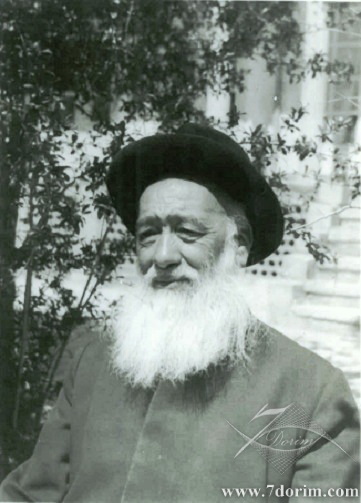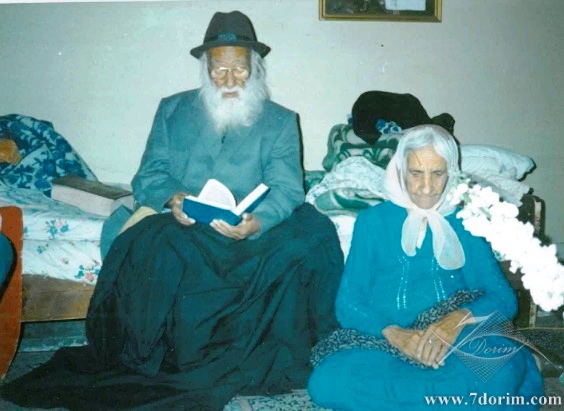
Mullah Shimon Yadegaran’s journey from a devoted student in Isfahan’s Jewish quarter to a revered community leader showcases his unwavering commitment to faith and service. This article explores the legacy of a man who balanced tradition with modernity and humility with authority, guiding his community for generations.
Life and Education
Family: a religious family in Isfahan
Mullah Shimon Yadegaran was born in 1936 in the Joubareh neighborhood, Isfahan, Iran, into a deeply religious family. His father, Mullah Avraham Yadegaran, was a respected religious leader of his time, and his mother, Bruria, was a righteous woman. Shimon had three sisters and two brothers.
Education: drawn to Judaism
Although Mullah Yadegaran never attended formal or even traditional maktab schooling, he showed a keen interest in learning the Torah from a young age and was deeply captivated by Judaism. He first learned the fundamentals of the Jewish faith and laws from his father. His talent quickly became evident as he soon mastered the principles of Gemara under the guidance of Mullah Rabbi Eli Yashar in Isfahan. He later traveled to Yazd to study with Mullah Rafael, a relative of Harav Orsherga, where he excelled among his peers. Shimon spent two challenging years in Yazd before returning to Isfahan, where he worked in a spinning factory, adhering to his belief that one should not make a living solely from religious duties.
Marriage: father of successful children
At the age of 22, Mullah Shimon married Sarah Zarrabi, chosen for him by his father. The couple had seven sons and one daughter, all of whom were successful and well-recognized in their personal and professional lives.
Religious and Community Leadership
Shimon was a social figure and was deeply involved in addressing the issues of his community. Having been born in Joubareh, he was intimately familiar with the inner workings of Jewish families in the area. Later, in 1974, he moved to Soraya Street near the Keter David Synagogue.
Religious services
Mullah Shimon served as the spiritual leader of the Jewish community in Isfahan for many years and was responsible for educating three generations of Isfahan’s Jews. He was fluent in Hebrew literature and had a deep knowledge of Persian songs and Piyyut (Jewish liturgical poems), which he sang eloquently. His responsibilities included officiating Mila (circumcision), Ketubah (marriage contracts), and Shechita (ritual slaughter). Although he did not leave behind any independent written works, he contributed significantly by annotating many religious texts.
One of the synagogues he frequented for religious services was the Nasi Synagogue in the Joubareh neighborhood. He was known for his unique style of blowing the shofar and leading the Tefillah, especially during Rosh Hashanah and Yom Kippur, leaving a profound impact on those present.
Official notary
Mullah Shimon’s office, which also served as his home, was operational from 1949. He registered 543 Ketubahs, the first of which recorded the marriage of Naima Eframian and Baruch Kalimi Gabbay in 1949.
Successor: Mullah Sedighpour
A father and son relationship
Mullah Shimon was highly sociable and had numerous friends and students, including Rabbi Shlomo Sedighpour, who was one of his disciples. In 1994 Mullah Shimon appointed Rabbi Sedighpour as his successor, entrusting him with the responsibilities of registering marriages and divorces. They were among the last traditional rabbis practicing in Iran. Rabbi Sedighpour described his relationship with Mullah Shimon as closer than that of a father and son.
Among the contemporaries of Rabbi Yadegaran was the esteemed religious scholar Monsieur Isaac.
Character
Independent: serving with no affiliations
Mullah Shimon was an independent rabbi, unaffiliated with any group, who took on the religious and social needs of his community single-handedly.
Promoting peace, embracing clear communication
He had an extensive knowledge of Halacha (Jewish law) and comprehensive understanding of all aspects of Judaism. Mullah prioritized peace, kindness, and tranquility in family and community life. He was able to lead the Jewish community of Isfahan with wisdom and empathy, always communicating his guidance in a simple and relatable manner. Mullah Shimon had a strong desire to see the Jewish community embrace modern sciences and skills, and his children became role models in this regard. He considered family as the cornerstone of society and placed great value on warmth, kindness, and stability within the household.
Humble, social, solution-focused
Numerous stories and anecdotes about Mullah Shimon’s proactive efforts in resolving social and familial issues still circulate in Isfahan. His qualities of humility, bravery, and deep knowledge, combined with his unflagging dedication to his community, made him an enduring figure in the city’s collective memory.
The Mullah was renowned for his humility, courage, cheerfulness, and willingness to share in the joys and sorrows of others. His reputation for his great knowledge and as a solver of people’s problems was well-established. A testament to his humility was his signature, which read, “smaller than a speck of dust in the sunlight”.
Death
Mullah Shimon Yadegaran passed away on October 10, 1994, corresponding to 5755 on the Hebrew calendar, at the age of 86. He was buried in the Serah Bet Asher Cemetery in Isfahan.
Timeline of Key Events
| Year |
Event |
| 1936 | Birth in the Joubareh neighborhood, Isfahan, Iran. |
| 1949 | Began registering Ketubahs at his office/home. |
| 1974 | Moved to Soraya Street near Keter David Synagogue. |
| 1994 | Appointed Rabbi Shlomo Sedighpour as his successor. |
| 1994 | Passed away and was buried in Serah Bet Asher Cemetery. |

Mullah Shimon Yadegaran and his wife, Sarah Zarrabi, Isfahan, 1990s.


 فارسی
فارسی